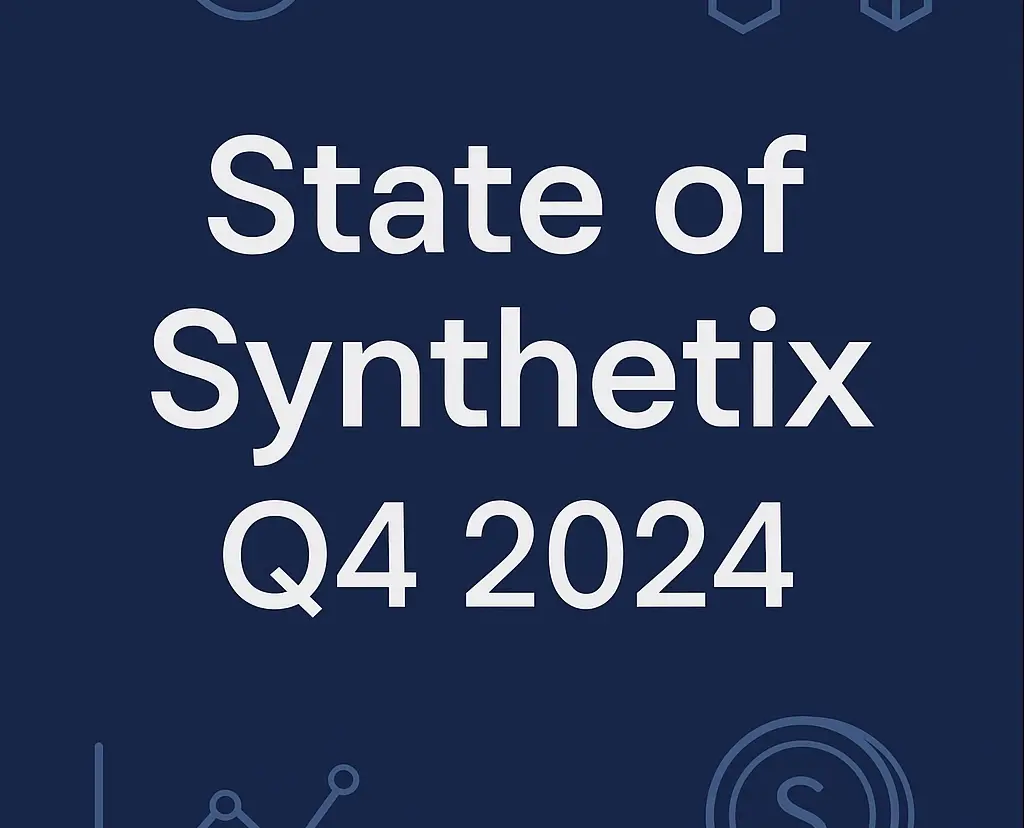Chapter 8: Decentralized Derivatives
Derivatives are contracts whose value is derived from other underlying assets, such as stocks, commodities, currencies, indices, bonds, or interest rates. Futures, options, and swaps are several common types of derivatives. Each type of derivative serves different purposes, and investors have varying trading objectives.
Investors trade derivatives for reasons including: hedging against volatility of the underlying asset, speculating on directional movements of the underlying asset, or increasing their asset holdings. Derivatives are inherently risky, and trading them requires extensive financial knowledge and strategies.
The total value of locked assets in DeFi derivatives Dapps is $114.3 million, accounting for 12% of the DeFi ecosystem^11^. Although this figure is relatively low compared to other DeFi markets (such as the lending market at $745.6 million), it is noteworthy that the decentralized derivatives market has only emerged for a year and has shown significant growth. Synthetix and bZx are currently the two mainstream DeFi derivatives projects.
In this book, we will delve into the largest DeFi derivatives protocol, Synthetix.
Synthetix

As the name suggests, Synthetix is a protocol on Ethereum for synthetic assets (called Synths). Synthetix consists of two parts: synthetic assets (Synths) and its exchange, Synthetix.Exchange. On Synthetix, users can issue and trade synthetic assets.
What are synthetic assets (Synths)?
Synthetic assets are assets or a mixture of assets that have the same value or function as another asset. Synthetic assets track the value changes of the underlying asset and allow exposure to the asset without needing to hold the actual asset.
There are currently two different types of synthetic assets—synthetic assets and inverse synthetic assets. Synthetic assets are positively correlated with the underlying asset, while inverse synthetic assets are negatively correlated.
Synthetic gold (sXAU) is a type of synthetic asset that tracks the price performance of gold. Synthetix uses Chainlink services to track the prices of real-world assets, with Chainlink's smart contract oracles obtaining price information from multiple trusted third-party sources to prevent data tampering.
An example of an inverse synthetic asset is inverse Bitcoin (iBTC), which tracks the inverse price performance of Bitcoin. Each inverse synthetic asset has three key data points—entry price, lower limit, and upper limit.
Let’s take the inverse synthetic asset iBTC as an example. Suppose at creation, the price of Bitcoin (BTC) is $10,600—this is the entry price. If Bitcoin drops by $400 to $10,200, then the value of the iBTC inverse synthetic asset will increase by $400, making its price $11,000. Conversely, if Bitcoin rises to $11,000, the value of the iBTC inverse synthetic asset will drop to $10,200.
The trading range for inverse synthetic assets is 50% above and below the entry price. This limits the maximum profit and loss that users can achieve on the inverse synthetic asset. Once either limit is reached, the token's exchange rate will be frozen, and positions will be liquidated. Once a freeze and liquidation occur, these inverse synthetic assets can only be exchanged at a fixed value on Synthetix.Exchange. They will then reset their upper and lower limits.
Why choose synthetic assets?
As mentioned above, synthetic assets allow traders to gain price exposure to the asset without actually holding the underlying asset. Compared to traditional gold brokers, synthetic gold (sXAU) enables traders to enter the market with a lower barrier (no registration, no travel, no intermediaries, etc.).
Synthetic assets also have another use—they can be freely traded among each other, meaning that synthetic gold can easily be converted into synthetic yen, synthetic silver, or synthetic Bitcoin on Synthetix.Exchange. This also means that anyone with an Ethereum wallet can now purchase any real-world asset!
How are synthetic assets generated?
The logic behind creating synthetic assets is similar to the logic of issuing DAI on Maker. Users must first collateralize ETH as collateral for Maker's smart contract before generating DAI based on the collateral posted.
For synthetic assets, you first need to collateralize the collateral that supports the entire system, which is the Synthetix network token (SNX). Compared to ETH, SNX has lower liquidity and its price tends to be more volatile. To address this issue, the minimum initial collateral required for Synthetic is at least 750%, compared to the 150% minimum initial collateral required by Maker.
This means that to issue $100 worth of synthetic USD (sUSD), you will need at least $750 worth of SNX as collateral.
Note: As of November 27, 2019, sUSD is the only synthetic asset that users can issue (mint)^12^.
The issuance of synthetic assets is a rather complex system. It requires collateralizers to take on debt, and the level of debt dynamically changes based on the total value of synthetic assets in the global debt pool, causing the debt owed by collateralizers to fluctuate with value changes. For example, if 100% of the synthetic assets in the system are synthetic Ethereum (sETH), and the price doubles, then everyone's debt will also double, including the collateralizer's own debt.
Once issued, these synthetic asset tokens can be traded on the Synthetix exchange or decentralized exchanges like Uniswap.
If you want to trade synthetic assets but do not want to take on debt or personally issue synthetic assets, you can purchase them in the sETH Uniswap pool. The sETH pool on Uniswap is currently the largest liquidity pool on Uniswap, with liquidity exceeding 35,000 ETH (approximately $8 million, calculated at $200 per ETH).
What assets are currently supported by synthetic assets?
As of the writing of this article, synthetic assets primarily support the following four asset classes (full list):
(i) Cryptocurrencies: Ethereum (ETH), Bitcoin (BTC), Binance Coin (BNB), Tezos (XTZ), Maker (MKR), TRON (TRX), Litecoin (LTC), and Chainlink (LINK)
(ii) Commodities: Gold (XAU) and Silver (XAG)
(iii) Fiat currencies: US Dollar, Australian Dollar, Swiss Franc, Japanese Yen, Euro, and British Pound
(iv) Indices: CEX Index and DeFi Index
Index synthetic assets
Index synthetic assets are one of the most interesting synthetic assets on Synthetix. As of the writing of this article, there are two different index synthetic assets, namely sCEX and sDEFI.
Index synthetic assets allow traders to hold a basket of tokens without having to purchase all the tokens individually. The index reflects the overall performance of the underlying tokens. Index synthetic assets allow for risk exposure in specific areas of the industry while diversifying, without the need to actually hold and manage various tokens.
sCEX
sCEX is an index synthetic asset designed to give traders exposure to a basket of centralized exchange (CEX) tokens, roughly proportional to their market capitalization. The current sCEX index includes Binance Coin (BNB), Bitfinex's LEO token (LEO), Huobi Token (HT), OKEx Token (OKB), and KuCoin Token (KCS).
There is also an inverse synthetic asset called iCEX, which operates in the opposite manner to the sCEX index synthetic asset, following the same principles as other inverse synthetic assets.
sDEFI
With the increasing attention on DeFi, the sDEFI index synthetic asset has emerged, providing traders with index exposure to a basket of DeFi application tokens in the ecosystem. The current sDEFI index consists of the following tokens: Chainlink (LINK), Maker (MKR), 0x (ZRX), Synthetix Network Token (SNX), REN (REN), Loopring (LRC), Kyber Network (KNC), Bancor Network Token (BNT), and Melon (MLN).
The inverse synthetic asset for this index is called iDEFI.
Interesting fact:
These index synthetic assets were created based on a series of polls on Twitter. The weight of each token was determined proportionally to its market capitalization, and then modified through community feedback.
Synthetix Exchange
Synthetix Exchange is a decentralized trading platform specifically for trading SNX and synthetic assets, without relying on the order book technology used by most decentralized exchanges. In other words, Synthetix Exchange does not rely on users to provide liquidity in a peer-to-peer system (like Uniswap and dYdX), but allows users to trade directly with contracts that maintain constant and ample liquidity, theoretically reducing the risks of price slippage and lack of liquidity.
Since users are purchasing contracts for synthetic assets rather than trading the underlying assets, they can buy all the collateral in the system without affecting the contract prices. For example, a $10 million buy/sell order for BTC might cause a significant price drop on a traditional exchange, but it would not cause price slippage on Synthetix Exchange, as users are trading directly with Synthetix contracts.
Additionally, Synthetix will launch a series of new trading features this year (2020), including support for synthetic indices and stocks, leveraged trading, binary options, synthetic futures, and trigger orders.
This is all about Synthetix's products—if you wish to learn more or try it out, we provide a step-by-step guide on how to generate synthetic assets. You can also jump directly to the next chapter for more information on the next DeFi application!
Synthetix: Step-by-step Guide
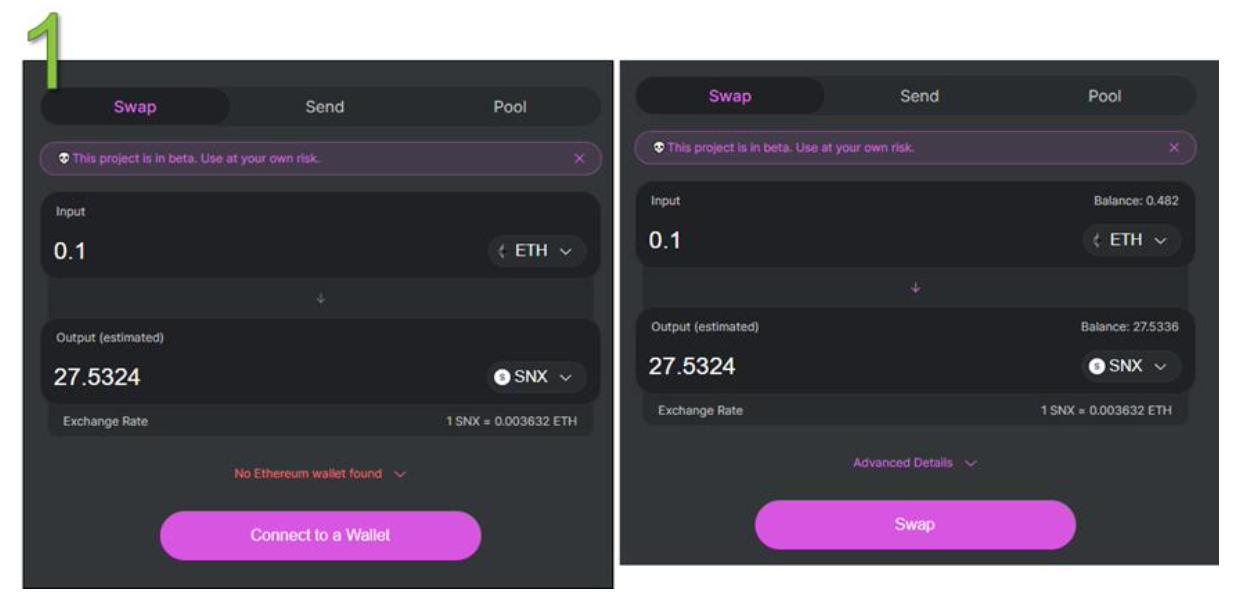
Step 1
- Before issuing any synthetic assets, you need to use SNX tokens for collateral.
- If you haven't used an exchange before, you can check our SNX page for a list of exchanges that support SNX tokens.
- In this tutorial, we will use Uniswap (https://uniswap.exchange/swap) to exchange ETH for SNX.
- Connect your wallet and enter the amount of ETH you wish to exchange for SNX.
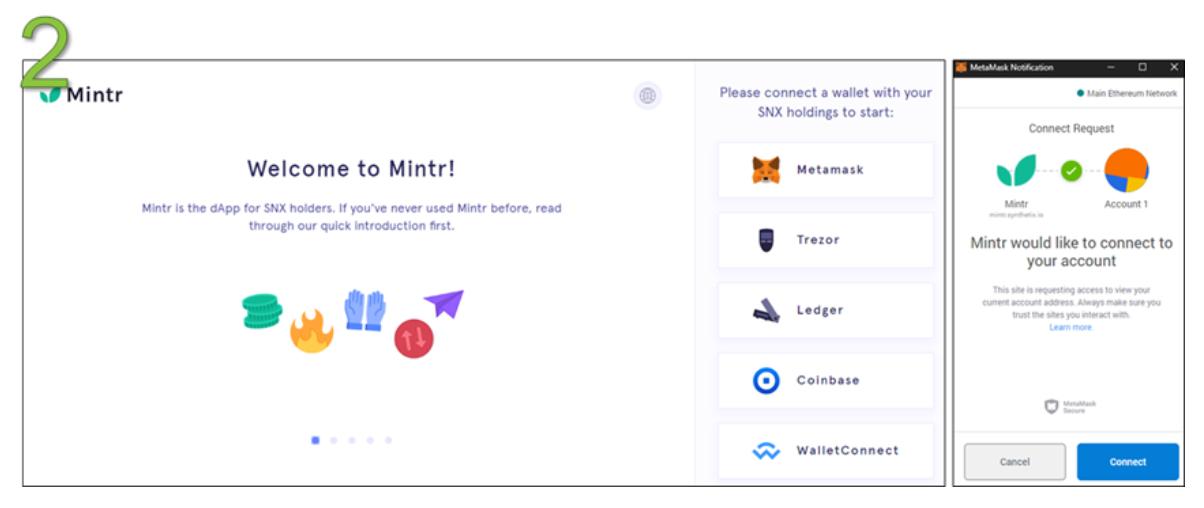
Step 2
- Create your synthetic asset by going to https://mintr.synthetix.io/.
- Connect your wallet.
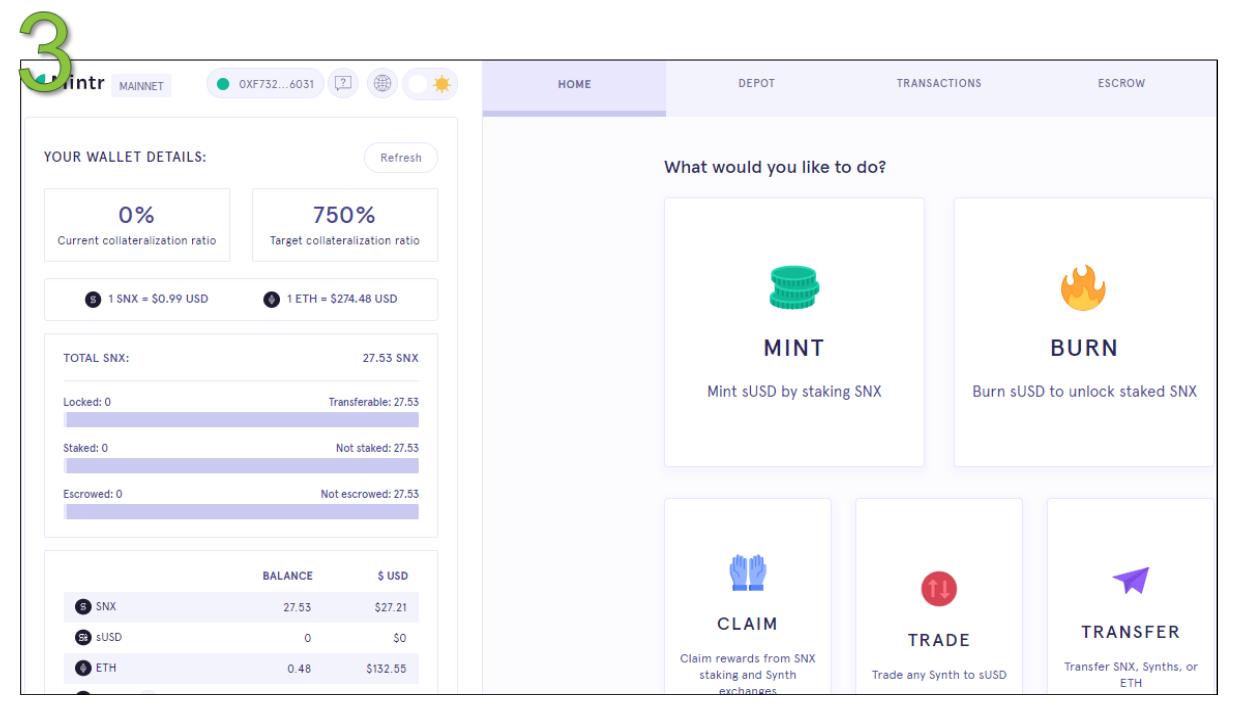
Step 3
- Once on the page, click "Issue."
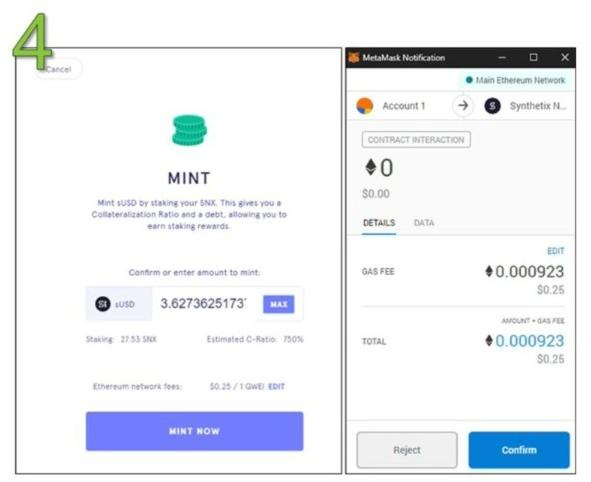
Step 4
- Enter the amount you wish to issue. Here I choose the maximum amount.
- Note: The amount that can be issued depends on the collateral ratio of SNX to Synth.
- The current collateral ratio is 750%.
- Therefore, $27.21 / 750% ≈ 3.63 sUSD.
- If this is your first time using it, you will need to enable it before making a transaction.
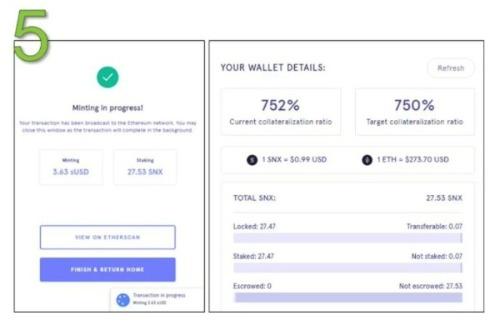
Step 5
- After confirmation, you will see your wallet balance as shown above.
Recommended Reading
- Crypto Derivatives, Lending, and a touch of Stablecoin (Gary Basin)
DeFi Use cases: The Best Examples of Decentralised Finance (Rajarshi Mitra) https://hackernoon.com/crypto-derivatives-lending-and-a-touch-of-stablecoin-59e727510024
The Ultimate Guide To Synthetix. (DefiZap and @DegenSpartan)
https://defitutorials.substack.com/p/the-ultimate-guide-to-synthetix
- Synthetix (Cooper Turley and Lucas Campbell)
https://fitznerblockchain.consulting/synthetix/
- Synthetix for dummies (TwiceCrypto)
https://medium.com/@TwiceCrypto/synthetix-for-dummies-477a0760d335
- Synthetic Instruments In DeFi : Synthetix (Joel John)
https://www.decentralised.co/understanding-synthetix/amp/?
Synthetic Assets in DeFi: Use Cases & Opportunities (Dmitriy Berenzon) https://medium.com/zenith-ventures/synthetic-assets-in-defi-use-cases-opportunities-19b11f57a776
The Value and Risk of Synthetix (Gavin Low)
https://medium.com/the-spartan-group/the-value-and-risk-of-synthetix-45204346ce






